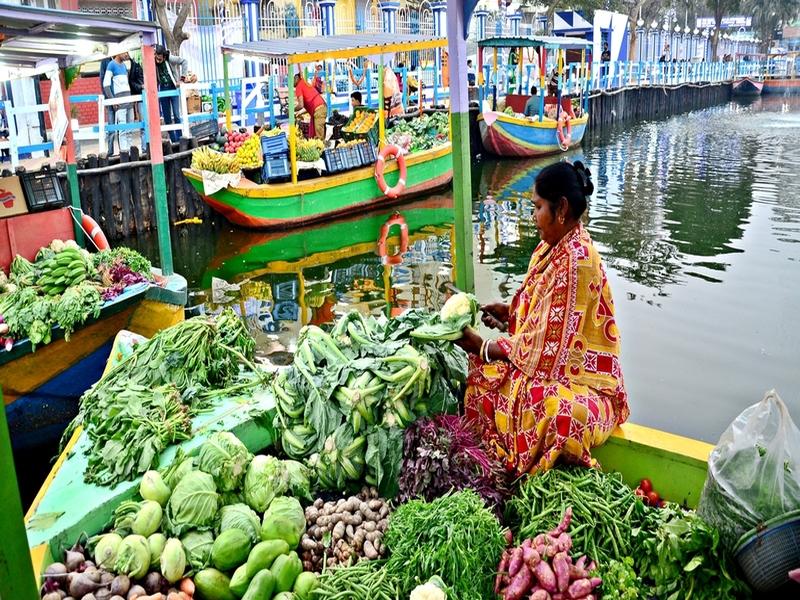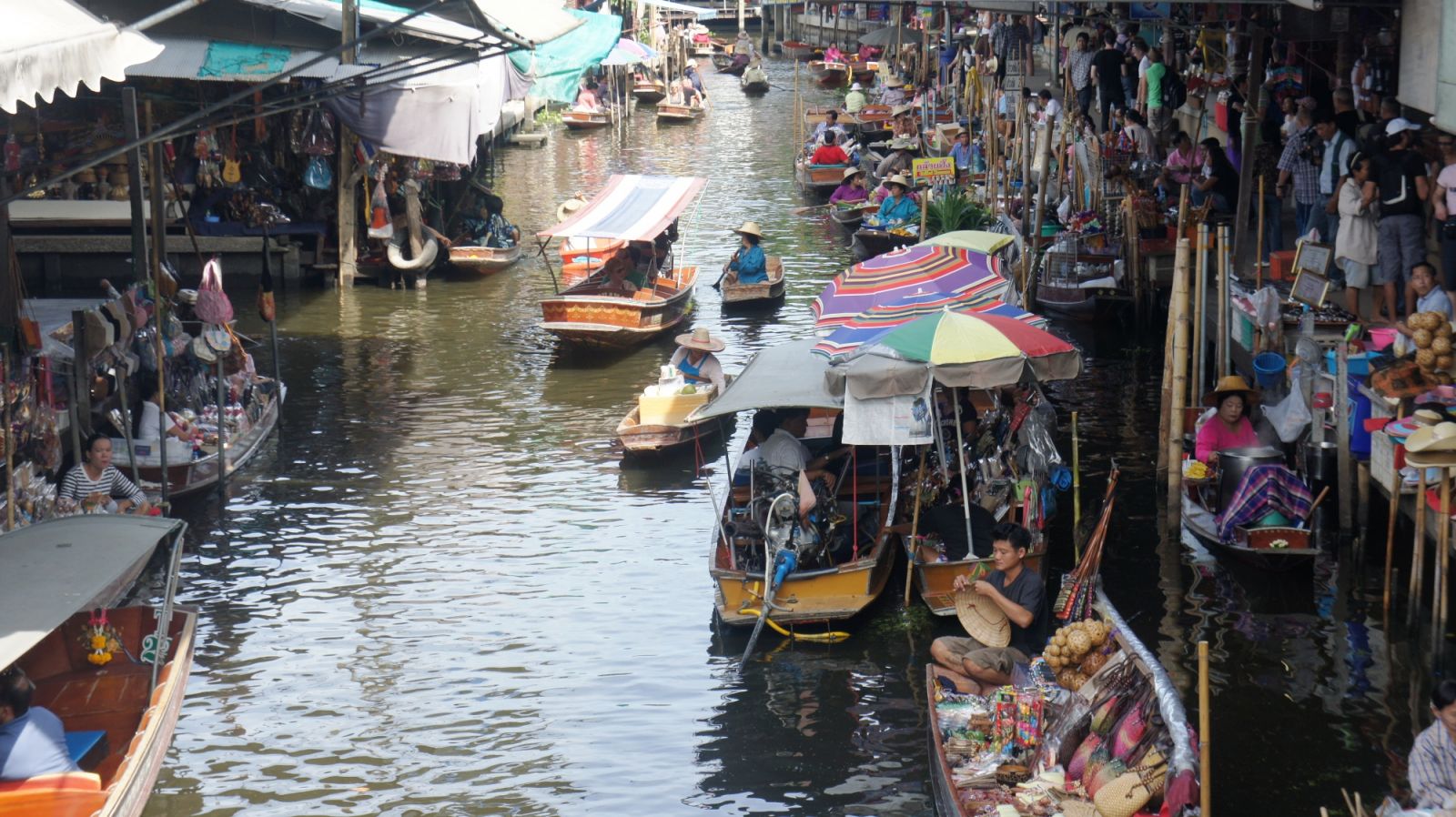 IMAGE
IMAGE
India's first floating market in Kolkata sets sail
Billed as the first floating market of India, Kolkata now has a slice of little Thailand in a 400 metre long and 60 metre wide water body in the city's southeastern fringe. TWF-IBNS correspondent Souvik Ghosh does a reality checks
Angela Banerjee may not be a regular visitor to the market but these days she loves to visit a slice of little Venice not too far from her neighbourhood where she can not only shop for essentials but also hang out.
“It is of course a beautiful place to hang out. It is an ideal place to click pictures while hanging out with friends,” says the young woman who at the newly opened floating market in Kolkata's Patuli area.
The market, which was inaugurated by West Bengal Chief Minister Mamata Banerjee on Jan 24, 2018, remains open throughout the day. One of the sellers says she comes at 6 a.m. in the morning and stays till 9 p.m. at night with a break in the afternoon.
.JPG)
Floating markets are dime a dozen in Thailand. But on a trip to Bangkok, the bustling Thailand capital, one of the major attractions on the outskirts is the floating market of Damnoen Saduak.
On a busy day teeming with tourists across the world, Damnoen Saduak offers a unique sight of a market that prospered in and around a network of inland waterways characterizing Thailand.
On a busy day teeming with tourists across the world, Damnoen Saduak offers a unique sight of a market that prospered in and around a network of inland waterways characterizing Thailand.
Kolkata's Tirtharaj, Baishali and Tuli, who were seen buying some items from the floating market in Kolkata, may not have visited Damnoen Saduak but gave a thumps up to the concept in this eastern city.
.JPG)
.JPG)
Baishali, who stays in Garia in the southern outskirts, says: “Feeling nice to come here. It is different. Earlier the place was completely empty and deserted. It looks good now.”
Taking a cue from Baishali, Tuli adds: “It is an amazing place. You (we) get such good vibes coming here.”
“The concept is very creative. It is something to be appreciated” says another friend in the group, Tirtharaj.
.JPG)
The primary purpose of the market is to rehabilitate the vendors who were displaced from EM Bypass of Kolkata due to expansion of roads.
From vegetables to fish to bindi, people can pick any item once they visit the market. Some visitors can even taste a few fuchkas (the crispy fried flour hollow ball filled with a mixture of spicy mashed potato stuffing and tamarind water) so famous in Kolkata as its signature street food.
However, in the Kolkata floating market, boats, instead of sailing through water, are anchored to the wooden piers from where buyers can bargain and buy.
From vegetables to fish to bindi, people can pick any item once they visit the market. Some visitors can even taste a few fuchkas (the crispy fried flour hollow ball filled with a mixture of spicy mashed potato stuffing and tamarind water) so famous in Kolkata as its signature street food.
However, in the Kolkata floating market, boats, instead of sailing through water, are anchored to the wooden piers from where buyers can bargain and buy.

Flower seller Pappu Natua says he is making more profits than the usual market which was along the EM Bypass, the road that connects the city to the airport.
Pappu says: “I am making more profits here (floating market). I am earning Rs. 500 per day. Really happy with the rehabilitation.”
Pappu says: “I am making more profits here (floating market). I am earning Rs. 500 per day. Really happy with the rehabilitation.”
Contradicting Pappu, Kamana Mondal, a vegetable seller, complains about the inability to hand over items to the buyers easily. She even says some items had fallen into the water, leading to her loss.
“It is difficult for me to give the food items to the buyers by standing on the boat. Some are falling in the water. I am making loss,” she says.

“It is difficult for me to give the food items to the buyers by standing on the boat. Some are falling in the water. I am making loss,” she says.

Another seller Bimala Halder says instead of making profits, she is losing. “Items are sold here at lower prices compared to other markets while my travel fares have gone up.”
The whole idea has not gone down well with several aged people who have voiced their displeasure over the market.
Kamalendu Ganguly, a Patuli resident, says the whole market will be a complete failure.

He says, “It is problematic for the older people. Accidents will certainly occur, some people will die and the entire market will be closed. This is inevitable. Moreover, it is tough to buy things. We can’t touch the items, hold it in hands. Problematic.”
Another buyer echoes the words of Ganguly. Though she loved the grapes and also appreciated the cheap prices in the market, he feels it is “impractical.”.
Another buyer echoes the words of Ganguly. Though she loved the grapes and also appreciated the cheap prices in the market, he feels it is “impractical.”.
The waste accumulation process in the market seems to be eco-friendly as none of the sellers are dumping wastes into the water to keep it clean. Wastes are accumulated in a storage which are dumped to the bin.
While only time can determine the fate of the market, colourful decorations coupled with bright lights have provided a unique destination for tourists and also people of the city to pay a visit.

Thailand's little Venice: Damnoen Saduk
Floating markets are many in Thailand. But on a trip to Bangkok, the bustling Thailand capital, one of the major attractions on the outskirts is the floating market of Damnoen Saduak.
On a busy day teeming with tourists across the world, Damnoen Saduak offers a unique sight of a market that prospered in and around a network of inland waterways that characterize Thailand.
Antique Buddha statues, swords, masks or lip-smacking Thai street food prepared by the women on boats, Damnoen Saduak is a tourist’s delight to shop effortlessly, appreciate some Thai delicacy or simply laze around reclining in your boat and take photographs as your boatman steers you around.
Damnoen Saduak is one of the largest among the floating markets in Thailand and in fact a trip to Bangkok is never complete without a visit to this one that has developed over time in the canal criss-crossed nation.
Bangkok’s inland waterways are its major attraction earning it the sobriquet Venice of the East.
(Images by Avishek Mitra/IBNS)
Top Headlines
-
Lifestyle
Birbhum: Sitaramdas Omkarnath Chair at Biswa Bangla Biswavidyalay
December 05, 2025
-
Lifestyle
Rediscovering Arunachal's Monpa Cuisine: One Womans Millet Momo Revolution
November 24, 2025
-
Lifestyle
Shiny things by Jinia: A luxury evolution by visionary entrepreneur, healer
November 19, 2025
-
Lifestyle
Mystique and Memories: Wiccan Brigade hosts its first Halloween Fest in Kolkata
November 18, 2025
-
Lifestyle
Rotary Club of Calcutta Samaritans hosts three-day youth leadership awards program for tribal students in Bakura
November 15, 2025
-
Lifestyle
Rotary Club, South Kolkata Vision inaugurate newly developed children's park in Sonarpur
November 15, 2025
-
Lifestyle
Bengali couple promoting Indian music and culture among young Americans
October 28, 2025
-
Lifestyle
Durga Puja sustainability: One of the oldest awards goes flex-free
October 17, 2025
-
Lifestyle
Education for All reaches out to support marginalized children during Durga Puja
September 27, 2025
-
Lifestyle
Rotary International District 3291 joins hands with JU, others to celebrate sustainable Durga Puja
September 24, 2025
